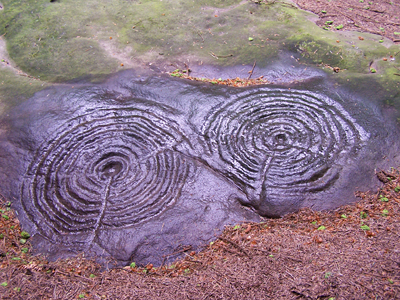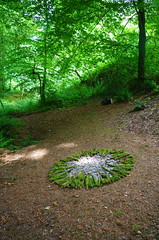A bit of philosophical rambling here…
When I first moved to this part of North Devon, on the Torridge estuary, I was dismayed to find there was no prehistoric rock art here (one of my abiding passions), and, as far as I could see, no ancient stone age sites at all. But the beauty of this coastal landscape and the abundance of land-based and marine wildlife, has more than compensated for this.

I think there is a spider crab under this lot
I never thought to hear myself getting enthusiastic about lobsters, starfish, pipefish, blennies, sea anemones and all those other aquatic blobs, but like most things, the more I learn the more I am filled with admiration. I nearly said ‘reverence’ there, but that would be going a bit too far…. Anyway, I am determined to talk about rock art today, because I miss it – and I am determined to make more of an effort to get to Dartmoor in future(a little over an hour’s drive away), where I know there is some Good Stuff.

Dartmoor stone circle – photo: J.W. Andrew
For now, I will stick with the ancient rock carvings, known as cup and ring marks, because that is what I know most about – which isn’t much. In the British Isles, these are found mostly in northern England and Scotland on rock outcrops and megalithic monuments. They look like their name: carved circular hollows, sometimes surrounded by concentric rings, sometimes found in complex designs with linking channels. Although no-one knows for sure, the main body of informed opinion is that they are associated with ritual and religious practices. I tend to go along with this myself, but also strongly believe that there is more to rock art than any specific meaning at any specific time.

A cup and ring-marked stone outcrop at Lordenshaws, Northumberland. Thought to be carved (pecked) during the late Neolithic period, over 4000 years ago.
Our attempts to define and understand cup and ring marks must inevitably be filtered through our current ‘Western’ scientific bias. There are, of course, some wild and fanciful speculations about the meaning of these carvings – ranging from celestial maps or ghost houses through to secret signs left by aliens. Some of these are ludicrous, for sure – yet I do take issue with those who criticise speculation as not being scientific. To formulate any hypothesis at all, about anything, one must surely start with some educated guesswork.
Science itself can only arise from our felt, subjective imaginative experience of the world. It is impossible to experience the world objectively. We can think about it objectively, but to do that, we have to a certain extent, to split ourselves off from the full matrix of our being. We have to become separate.
It is my belief that in those ancient, pre-literate, pre- scientific times, people did not, as we in the 21st century tend to do, see themselves as separate from the forces and forms of nature all around them. I think they knew themselves as an intrinsic part of one living, endlessly transforming universe. This would have led to them seeing no real difference between practical tasks such as boundary-marking or burying the dead, and seasonal religious ceremonies – all would have been a necessary and important part of life.They may or may not have conceptualised natural forces as being spirits or demons, but in carving out their hollows and channels, it seems to me they were seeking to penetrate and connect with the very essence of life itself.
Rock art is an endlessly fascinating topic. A great deal of painstaking research and analysis has been done over the last decade or so, and there is still a huge amount more to be done. My own interest in rock art lies not so much in the important work of mapping and categorising, but in what it can tell us about the human condition.
Looking at these carvings, I am drawn into an intimacy with something I recognise, whose meaning is just out of reach… something that feels like home.
Here are some excellent sites for further exploration:
The Modern Antiquarian
The Megalithic Portal
The Beckensall Archive
British Rock Art Collection
Cupstones








thanks for the most welcome reading material.
No, I had not considered the grooves in rock art/ cup and ring marks etc. as finger canals for prayer rituals, though I have come across the idea applied to small modern table-top labyrinths.
It does seem, at least, a possibility, and deserves more thought.
LikeLike
P.S. Thoroughly enjoyed this post.
LikeLike
Rock art is an endlessly fascinating topic.
Indeed it is… Have you ever read Scott Peck’s In Search of Stones?
I’m wondering if those coiled designs may have been labyrinths with finger canals employed for prayer rituals as described towards the bottom of this page:
http://www.labyrinthina.com/path.htm
LikeLike
you are succint and articulate:
It is my belief that in those ancient, pre-literate, pre- scientific times, people did not, as we in the 21st century tend to do, see themselves as separate from the forces and forms of nature all around them. I think they knew themselves as an intrinsic part of one living, endlessly transforming universe
and i absolutely agree!
LikeLike
Thank you Steve! It was quite a struggle to clarify what was in my head- so I am glad it made some sort of sense.
Now you have given me more to think about, which is unfortunate, because I thought I had exercised my brain enough for a few weeks….
Yes – it seems clear to me that these carvings are an early form of labyrinth – though I dont have a great deal of supporting evidence for this.
‘The way in is the way out.’ I like that!
LikeLike
Linda, if I may quote you:
Science itself can only arise from our felt, subjective imaginative experience of the world. It is impossible to experience the world objectively. We can think about it objectively, but to do that, we have to a certain extent, to split ourselves off from the full matrix of our being. We have to become separate.
You have nailed it; to be a scientist, you must pose as a scientist. As, to be an artist, you must pose as an artist. Act as an artist does as if you were an artist. Presto-chango, you ARE an artist. We become what we imitate. Every child is proof of that.
I thoroughly enjoy your post and your photos. I am concerned with consciousness myself, which happens to be my consciousness as the only valid sample of the beast I can become acquainted with.
Some of the stone circles in your photos are definitely a traditional form of labyrinth. The way in is the way out. The ancients discovered that long ago.
Steve from Planet Earth (blogger on consciousness)
LikeLike